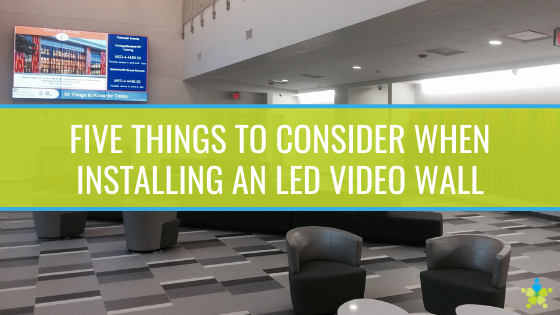[vc_row][vc_column][vc_column_text]
There Is A Lot To Consider When Installing An LED Video Wall
LED video walls are impressive to behold and can make an impressive impact for an organization, but they require significant planning before execution. After all, a video wall can be scaled up to almost any size and in almost any shape, so there’s a lot of room to get creative. Beyond that, though, there’s also cost, space, power and positioning to consider, but the added research is worth it, as few technologies grab attention like an LED video wall.[/vc_column_text][/vc_column][/vc_row][vc_row][vc_column][vc_column_text]Why Should Organizations Consider An LED Video Wall?
Video walls can be found in all kinds of settings, displaying a variety of messages. They are, in short, considered a compelling option by organizations in numerous industries. Here’s why:- Unmatched visual punch - People are visually oriented, and research shows that out-of-home digital advertising gets more attention and holds that attention for longer. An animated or vividly colorful image stands out in most settings, and an LED video wall can deliver those at a scale that’s impossible to miss.
- Endlessly versatile - Video walls are a communication tool first, so no matter what your organization chooses to communicate, a video wall is an ideal medium. Whether it’s new additions to a menu, information about an upcoming sale, PR-related media or directions to a nearby point of interest, an LED video wall is the right tool for the job.
- Effective and efficient - Previous display technologies, LCD most notable among them, have utilized LED lighting, but not to the degree that modern LED video walls do. In a modern LED display, the LEDs directly provide the image, which makes for a brighter image. LEDs are prized for their durability and energy efficiency. They can provide consistent lighting for years before replacement is required, and minimum maintenance is needed until then. Also, LED’s superior energy efficiency lowers its operating costs, which is especially important for displays expected to operate around the clock.
Five Things To Keep In Mind When Planning An LED Video Wall Project
LED video walls are huge undertakings, physically and logistically, but if your organization is prepared, there’s likely to be few surprises. Here’s five questions to help with that preparation:- What kind of displays will we need? LED video walls come in a variety of builds and it’s likely there’s a product for your exact need. First, make sure not to rely on anything other than commercial grade displays for your video wall. Commercial displays are designed to operate around the clock with their superior heat management. Some LED video walls can be installed outside, while others can be formed to just about any shape imaginable. For example, Samsung’s The Wall can be contoured around corners, even around entire buildings. LED video walls don’t have to have that grid-like bezel pattern that once characterized the technology.
- Where will the video wall be positioned? A primary consideration for your organization’s LED video wall project is location. Where the video wall is installed will have a major impact on its overall effectiveness, so pick a spot where high foot traffic is expected. Don’t forget about pixel density when positioning the video wall, either. Pixel density refers to the amount and size of pixels present in the display, and this will have a big impact on how the video wall appears. If your video wall’s pixel density is low, then installing it further away is a better approach. With a greater pixel density, the image will look sharper at close range, so consider installing such a video wall where people can get close and take in the full image.
- What kind of content will the video wall display? Video walls can display anything, from text-heavy information to complex animations. Content is what drives the technology, so the content your organization uses will determine how to make optimal use of the video wall. For instance, if your organization will lean toward animation and other imagery, then your video wall will be effective at most distances and at larger sizes. If your video wall is intended for text, schedules and the like, then reduce the distance between the display and observers.
- How accessible will the video wall be? Accessibility means two things in this context. One, it’s important that an LED video wall not interfere with walking paths or violate any ADA (Americans with Disabilities Act) regulations. Even something as basic as how far the video wall will stick out from the wall will intersect with an ADA regulation. Two, though LED lighting is the most durable and reliable on the market, the occasional adjustment will be needed to keep the video wall looking perfect. For this reason, it’s essential that any video wall be installed in a place where easy maintenance is possible. Is there room behind the video wall to access cables? Is there enough room to vent heat? What if part of the display needs to be shut down for maintenance? These details must be considered before the LED video wall is installed.
- Who is going to install and maintain the LED video wall? Video walls are a project for experts. There is a lot of hardware to handle, configuration to manage and small details to figure out to ensure proper integration. That’s why most organizations turn to a certified AV integrator to oversee the planning, installation, configuration and maintenance of an LED video wall. A certified integrator will custom design an LED video wall for the intended installation space, will select the right components and displays for the job, calibrate everything for ease of use and provide long term maintenance, if desired. This will ensure your organization’s video wall is as visually compelling and as long lasting as it can be.



